Scales won’t get you playing killer bass lines.
Over and over again, on forums, on reddit threads, in lessons, people offer up scales as this mystical, magical key.
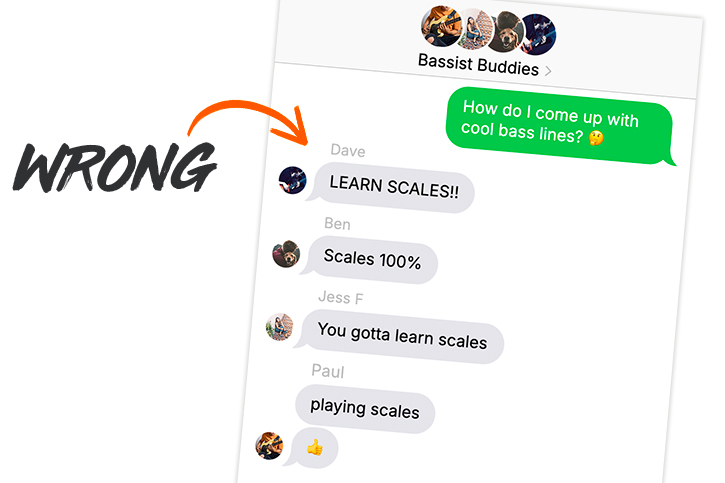
But scales won’t get you playing killer bass lines.
Sure, scales are going to be a part of playing killer bass lines.
But scales are only ingredients. You’ll need them to cook up excellent bass lines, but just like ingredients in a kitchen, they only taste good if you know what to do with them.

Ingredients are not recipes. You don’t eat spoonfuls of raw flour, a stick of butter, a raw egg, and a handful of sugar and call it a cookie. Scales, by themselves, are not killer bass lines.
Killer bass lines are like delicious recipes prepared by a talented chef. They are a combination of delicious ingredients mixed and cooked to perfection.
If you learn enough killer bass line recipes – if you can see what the individual ingredients are that produce the PHENOMENAL musical results that you love – you will begin to have mastery over your ingredients and you will create KILLER BASS LINES.
Most websites, videos and teachers treat bass scales as though scales alone are what you need to play bass lines. This is like handing someone a sack of flour and asking them to bake you blueberry muffins.
How much do I use?
What else do I put in the muffins?
Where are the blueberries??
What good is a scale form if you don’t know what the hell to do with it?
In this article you will learn scales and what to do with them. You’ll learn the musical ingredients every bassist needs, and also the recipes that show you how to cook up delicious bass lines.
I’ll show you the 5 most important bass scales.
In fact, if you just came here for scale forms, here are the 5 scales that I’ll be going over in this article.
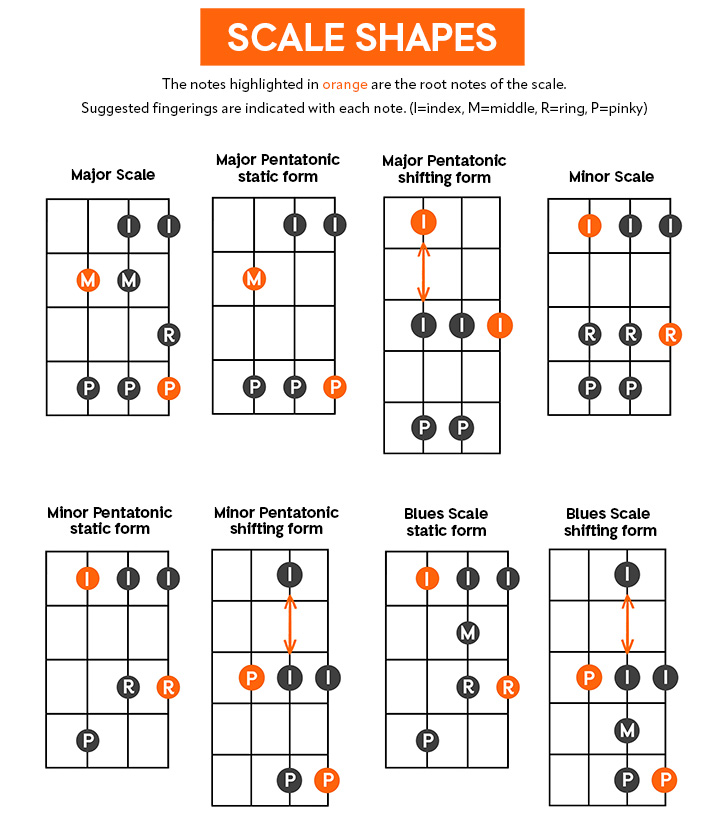
What You’ll Learn
For each scale I’ll show you the following:
- The bass scale fingering
- A bass line or two that uses this scale & fingering
- How to practice this scale in musical ways
- How you can create your own bass lines with the scale
We will begin with the most fundamental of all questions:
#1What Is A Scale?
You are entering the kitchen.
You want to make delicious cookies.
The recipe calls for butter, eggs, sugar, flour and, maybe, chocolate chips.
If you don’t know what butter is, your cookies will be bad.
If you mistake the sugar for the salt, your cookies will be bad.
If you use raisins instead of chocolate chips, I will personally come to your house and fight you.

Understanding your ingredients matters.
If you use the wrong ones in the wrong recipe, everyone will hate your cooking.
If you’re on the funk gig and everyone is playing dirty, nasty funk jams and you bring out your sweet, Christmas Carol scale it will be bad.
If you’re at the Christmas service and everyone is singing Silent Night and you bring out your dirty, nasty funk riffs it will be… bad? Yeah, probably.
This is why knowing what a scale is and knowing the difference between your scales is so very important.
So let’s clarify.
The kitchen of every musician is filled with 12 things. The 12 notes of our particular music system.
There are only 12 notes, and they are laid out pretty clearly on both a piano and the electric bass.

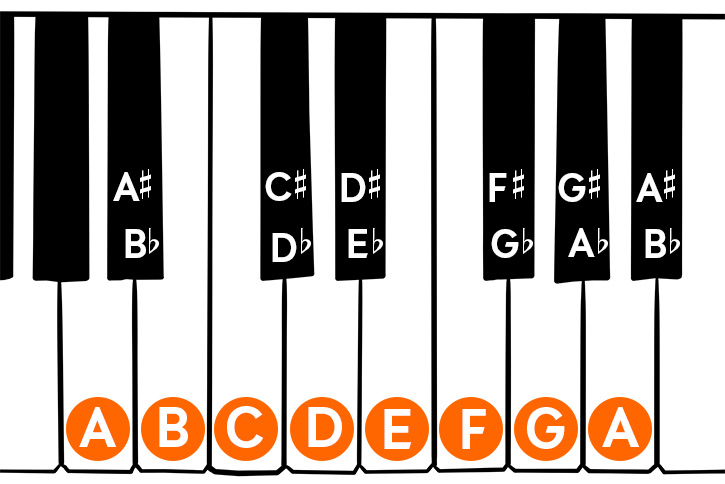

If you throw all 12 ingredients into everything you play all the time… it will taste terrible.
It’s helpful to select specific ingredients so that you can control the flavor of the music you’re trying to make.
A scale does that for you.
A scale selects ingredients that work well together and create a specific sound for the music.
#2What You Need To Know First
When you learn a new scale, you need to learn the form and fingering well enough to be able to play it easily from any note on your bass.
The FORM of the scale is the visual and physical shape that the scale forms on your fretboard.
Here’s the major scale form from the all-scales PDF above:
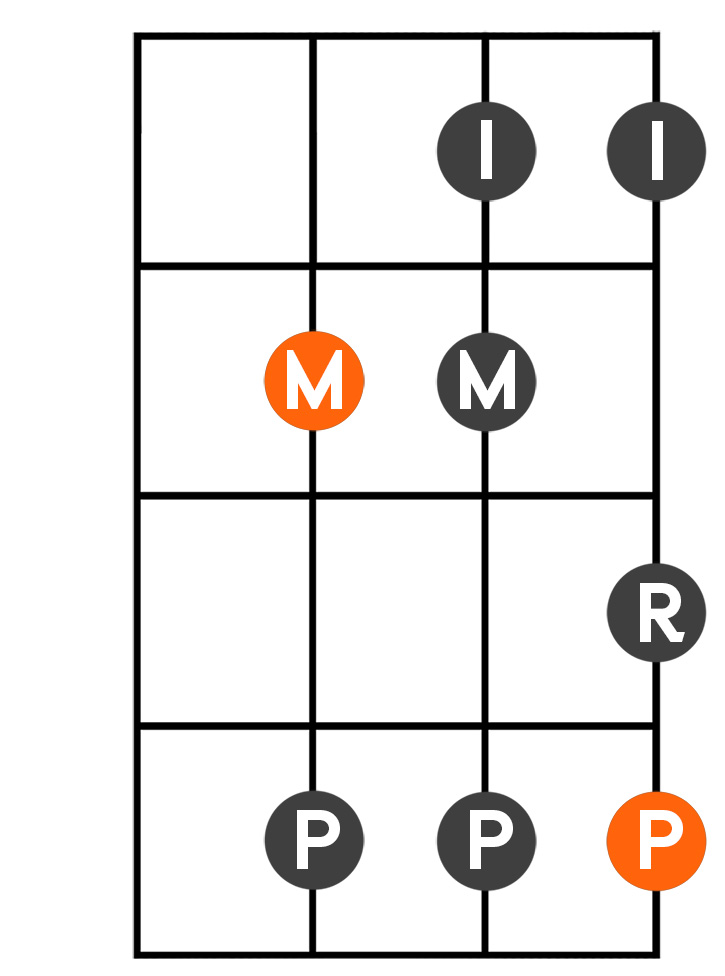
The IMRP letters tell you the suggested fretting hand fingering for the scale:
I – Index finger, Pointer Finger, 1st finger
M – Middle finger, The Bird, 2nd finger
R – Ring finger, 3rd finger
P – Pinky, the weak one, 4th finger
Here’s what it will look like in the music examples:

And here’s what it looks like on your hand:

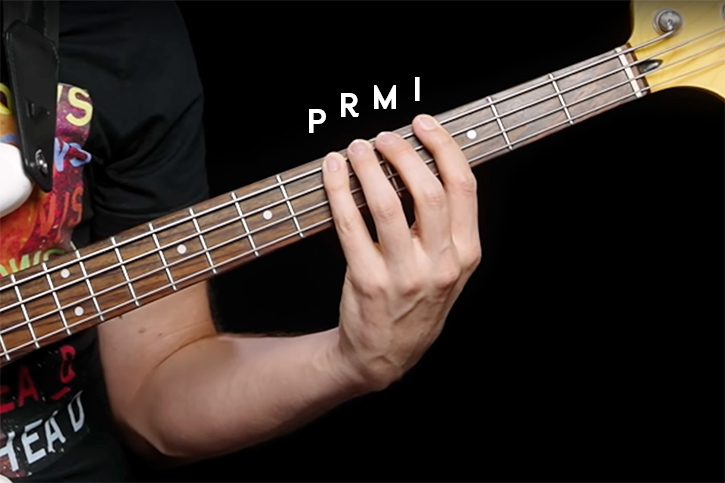
When you play a scale, either ascending (going up in pitch) or descending (going down in pitch), you’ll be starting from the root note.
The ROOT NOTE of a scale is where every bass line will begin. It is the note that gives you the I-am-home-sigh-of-relief feeling when you land on it.
- A C Major scale is a major scale that starts on C. C is the root of that scale.
- An E Major scale is a major scale that starts on E. E is the root of that scale.
- An F Minor Pentatonic Scale is a minor pentatonic scale that starts on F. F is the root of that scale.
If you don’t know where notes are on your bass, don’t worry about it. You won’t need to know any of that for this article.
A Word About Fretting Hand Fingerings
I’m gonna show you my suggested fingering for each scale form. The fingering you use in the scale form should be the same fingering you use when you’re playing those notes in the exercises and song excerpts.
The fingerings I’m recommending are the ones I use, and I can vouch for them.
If you run into any troubles or want/need to change things to suit your body and hand, that’s fine. Just remember:
- Keep things consistent. The muscle memory of scale forms makes these bass lines and exercises so much easier to learn!
- Keep things relaxed. You want a relaxed, comfortable hand at all times.
- Keep things efficient. It might feel easiest to play everything with your two strong fingers (usually index and middle). But! Playing with only 2 fingers – when you have 4 working fingers – would be massively inefficient, and will run you into all kinds of walls as bass lines get harder. Keep that in mind if you change a fingering, and remember to stay efficient.
#3The Major Scale


The major scale is the sugar of your bass kitchen. It’s the melody making machine that you’ve heard in just about every pop song, Christmas carol and nursery rhyme. It can sound happy, triumphant, even sad – but it’s always sweet.
Here’s an example of this scale in action that you may be familiar with.
Note: this is a melody, not a bass line.
Here are the ingredients that the melody uses:

And now, here’s the actual recipe – the way that the notes are played to get the actual melody:

Bass lines that use The Major Scale
ABC by The Jackson 5 (chorus only)
The bass line to ABC by The Jackson 5 is a killer example of the major scale in action. Every note of the scale will be used but not in order. This is why identifying the scale ingredients of a great bass line recipe can be so hard: the notes might be all there, but they won’t be in strict scale-practice order.
Just the scale – all by itself – up and down – is very, very rarely the best choice for your bass line.
Here are the ingredients:

And here is the specific recipe with these ingredients:
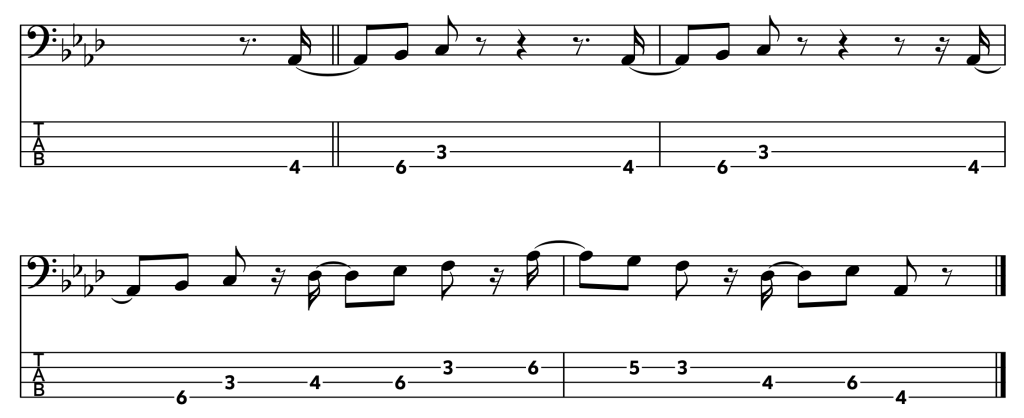
The root note – or home – for this song is Ab. It’s not an easy bass line so take it slow.
If it’s too challenging right now, move on to the scale exercises and come back to the bass line once you’ve gotten the scale more comfortable under your fingers.
How To Practice The Major Scale
To begin getting familiar with a new scale, start with repetitive scale form practice to learn the pattern and get the information out of your eyes and brain and into your ears and fingers. This is you gathering your ingredients:


This is where most scale instruction ends.
Most beginning bass players are left with a sackful of dry, raw ingredients and no idea how to craft delicious recipes.
Good thing you’re here.
To turn your ingredients into a tasty recipe you need to do what every great learner does: COPY.
Take elements from the bass line you just learned (ABC) and turn them into an exercise so that you can practice the scale in a practical and musical way that relates directly to a delicious bass line recipe.
ABC works with a 3 note bass line, and the 3 notes are always right next to each other in the scale. It’s a pattern within the pattern of the scale.
To turn boring up-and-down/down-and-up scale practice into something musical, take the 3 note pattern from ABC and try it out starting from every single possible place in the scale in both directions.
Here is what that looks like:
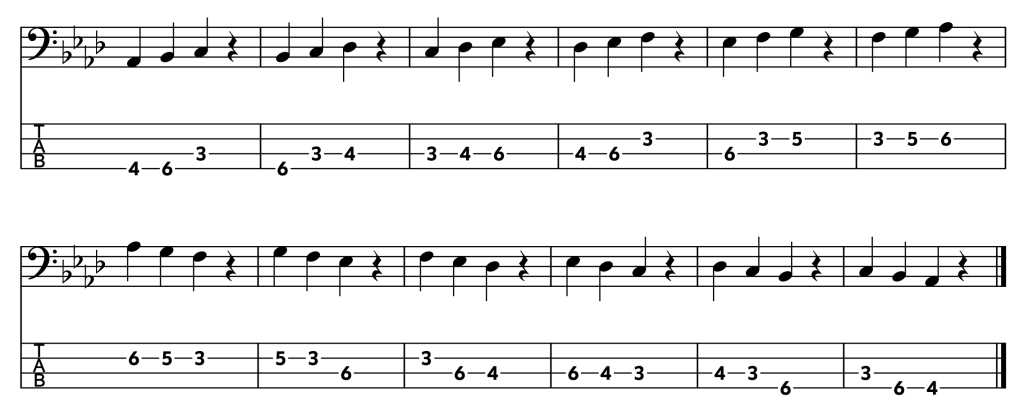
The scale practice sounds melodic and musical now! Success.
How To Make Your Own Bass Lines Using The Major Scale
Now it’s time for you to start making your own bass lines. It’s time to boldly step into the bass line kitchen and get cooking.
Once again, the way to begin using these ingredients successfully is to learn and copy successful recipes.
To turn scale practice into something that sounds like a real bass line, you’ll need to steal something else from ABC: that hip, bouncy rhythm.
In the final major scale exercise, you’re going to play that same 3 note pattern that you just learned but this time, add the rhythm from ABC. It looks and sounds like this:
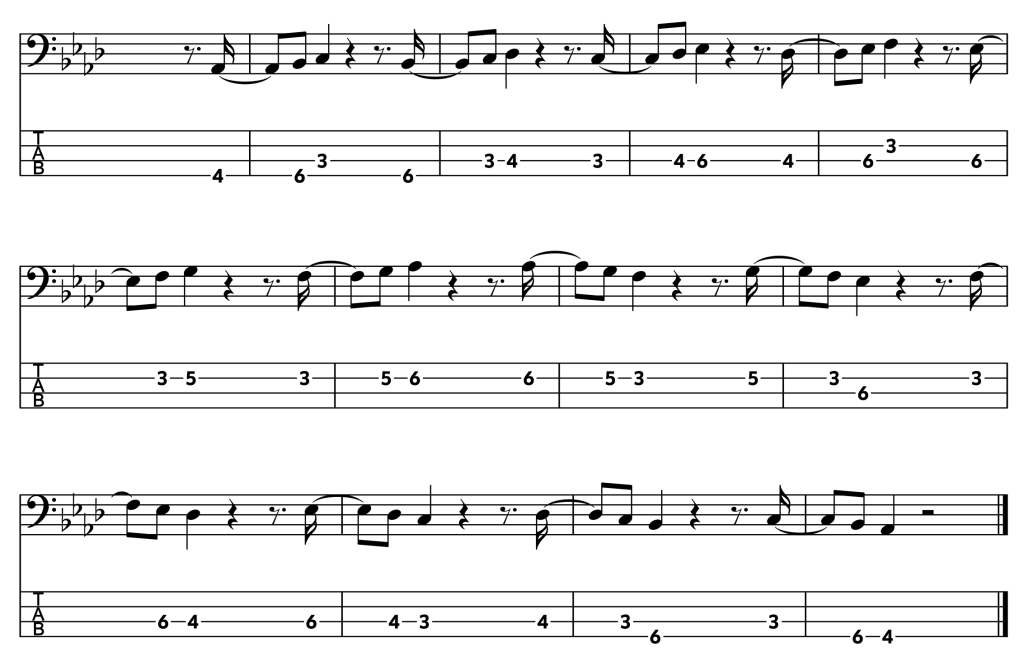
Once you can play these pieces of the scale and apply cool rhythms, the next step is to start experimenting.
Just like messing with things in the kitchen, you will have failures and successes. When it goes bad, go back to the root note, settle down, and start over.
When it goes great – just like with a great improvised recipe – REMEMBER THAT S**T! Turn on your voice memo recorder, write it down, do whatever! That’s your new bass line!
To help you get comfortable making messes in your kitchen, here are two more experimental bass line recipes. Each one uses the material practiced above to try and make something cool and musical.
In these examples you’ll see that there are some repeated notes in addition to the patterns we played.
Hark unto the Mantra of the Grooviest Order of Bass Players:
“Never Underestimate The Power Of Repeated Notes!”

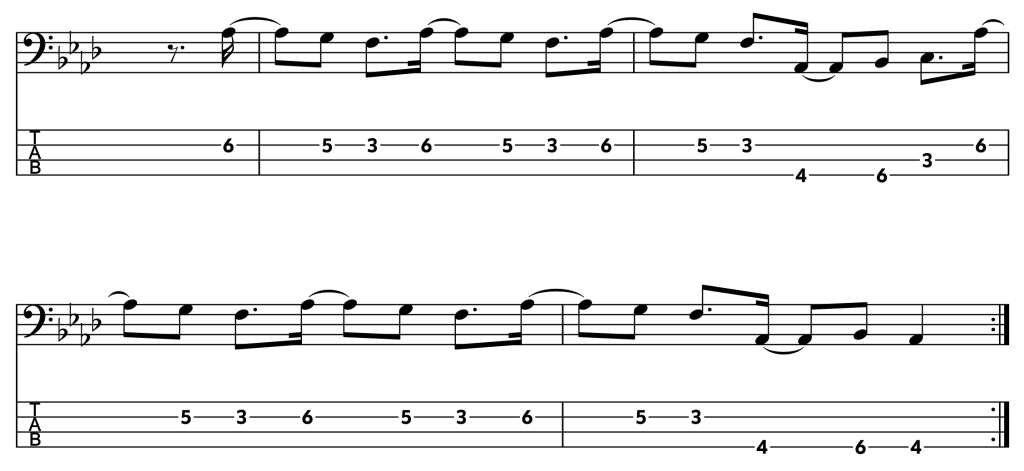
#4The Major Pentatonic Scale

The Major Pentatonic Scale is your butter, your olive oil, even your bacon grease. It makes everything smooth and tasty. This is a 5 note scale: Pentatonic = Penta (latin for 5) + Tonic (latin for note). It’s like the major scale but you’ve taken out the two notes that have the highest potential to make your bass line sound bad and ruin your recipe. It’s a smooth, sweet, versatile scale that can sound bouncy, jaunty, funky, groovy, bluesy or just plain ‘ol nice.
There are two ways to play this scale: the static form, and the shifting form.
I’ll start with the static form.

This is a pattern for the major pentatonic that is perfect for seeing how closely it is related to the major scale. It’s great for other things too – like playing the iconic guitar line from My Girl:

Now the shifting form.
This form has a flow and glide to it that is comfortable for the hand and makes certain lines easier to play.

You’ll use the shifting form in the bass lines that follow.
Bass lines that use The Major Pentatonic Scale
I Can’t Help Myself (Sugar Pie, Honey Bunch)
This song has a killer bass line pattern. It’s also a bass line by a master chef of some of the world’s finest electric bass recipes, Mr. James Jamerson. In this example Jamerson takes a classic bass line pattern and plays it from 4 different places.
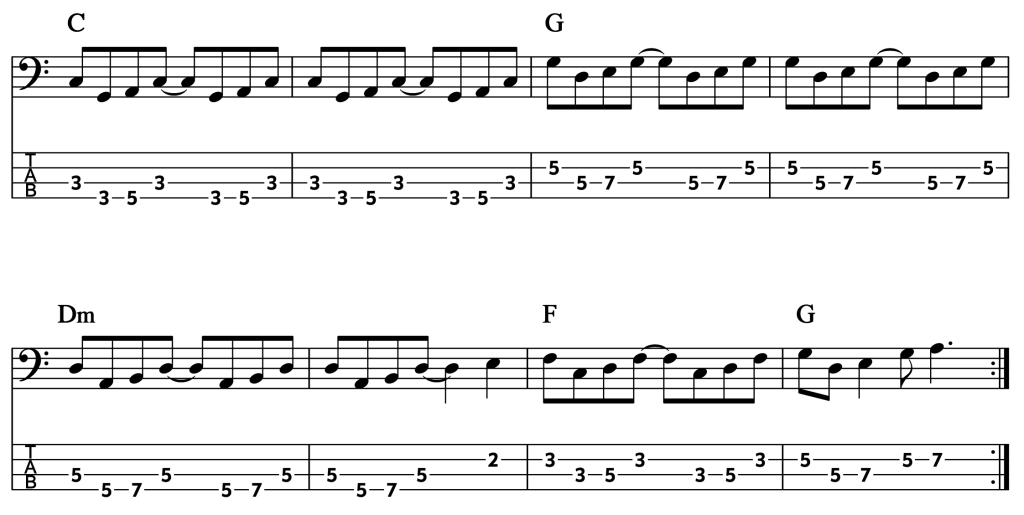
Crazy Little Thing Called Love
The main repeating bass line of Crazy Little Thing Called Love, by Queen, has another great Major Pentatonic scale pattern as well as a little sliding maneuver that is crucial to making this scale form sound smooth and just a little bit greasy.


How To Practice The Major Pentatonic Scale
Once again, the first thing to do is play the scale form ascending and descending until it is hardwired directly into your hand and ears.
Here is the shifting form (the one I use the most) from both a low root and a high root:


Here’s how to make your major pentatonic scale practice musical, practical and, possibly, groovy:
Take the most used patterns from this scale in these songs and isolate them. These are combinations of notes that will show up in bass line after bass line after bass line. These are combinations of ingredients that just work. Like garlic, olive oil and tomatoes. Like avocados and cilantro. Like butter and… everything.



How To Make Your Own Bass Lines With The Major Pentatonic Scale
To figure out how these patterns work for you, you need to experiment with them. What order can you put the notes in? What notes can you repeat?
The examples below show two bass lines using the pattern from I Can’t Help Myself and two bass lines using the pattern in Crazy Little Thing Called Love. These are samples, and are hopefully just the beginning of your own explorations with this scale and these patterns:





The more you experiment, the better you’ll get at whipping up just the right bass line for whatever situation you find yourself in.

Are you (ahem) hungry for more killer beginner bassist material?
Check out our beginners course.
#5The Minor Scale
Are you in a metal band that wears corpse paint?
Do you live in an old abandoned castle?
Do you wish the world was just a little bit sadder?
Well, good news for you: here’s The Minor Scale.
This scale excels at making things sound dark, spooky, sad, melancholy, dangerous, and epic (in a sad way).
This is not the scale that brings us our National Anthems or Happy Birthday. This is Beethoven’s DUN DUN DUN DUHHHHH! It’s that sound the organ makes when a Vampire walks into their lair.
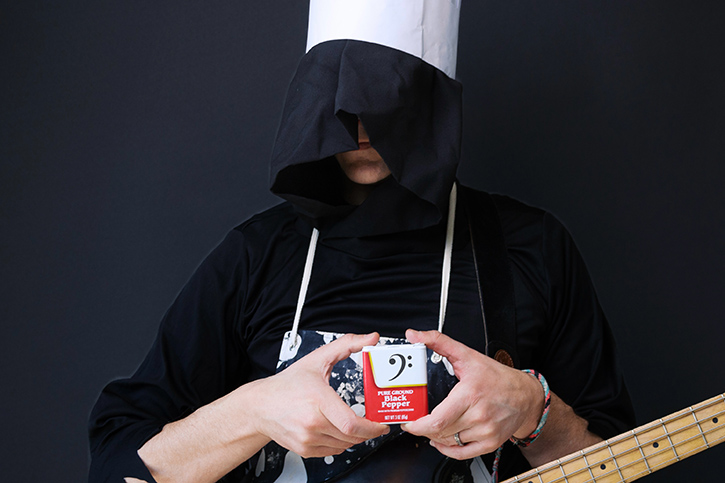
The Minor Scale is the black pepper in your kitchen. It’s classic, it’s full of flavor but that flavor is dark and kind of spicy.

Bass lines that use The Minor Scale
Feel Good Inc.
Feel Good Inc. is a great minor scale bass line. It sets the dark, doomy mood for the entire song.


How To Practice The Minor Scale
As with every scale we cover – the first step is getting it into your ears and your fingers from either a low root note or a high root note:


To give you a better sense of the flavor of this scale and give you more practical recipes to taste and learn from, here are 3 more iconic lines that use the minor scale.
Crazy Train! Disclaimer: This is a guitar line. It is very difficult to play at tempo in this low area on the fretboard where the frets are so far apart! But it is iconic and killer, and is a lovely use of the minor scale.


Them Belly Full, by Bob Marley, uses an A minor scale but – tricky tricky – Aston “Family Man” Barrett uses the open A string as his starting root note. This changes the look of the scale pattern, but not the sound or the relationship of the notes with each other.


The little deedle deedle deedle in Iron Man owes everything to the minor scale!


How To Make Your Own Bass Lines Using The Minor Scale
The road to originality is paved with copying. The rhythm of the Feel Good Inc. bass line recipe is very tasty. I’ll keep as much of it as I can, and try it with some different notes. Any note in the minor scale will work. I’ll follow one more rule from Feel Good Inc to ensure a killer bass line recipe:
Start on the root note.
The first part of the bass line will end on a note that is NOT the root note.
The second half of the bass line will end BACK on the root note.

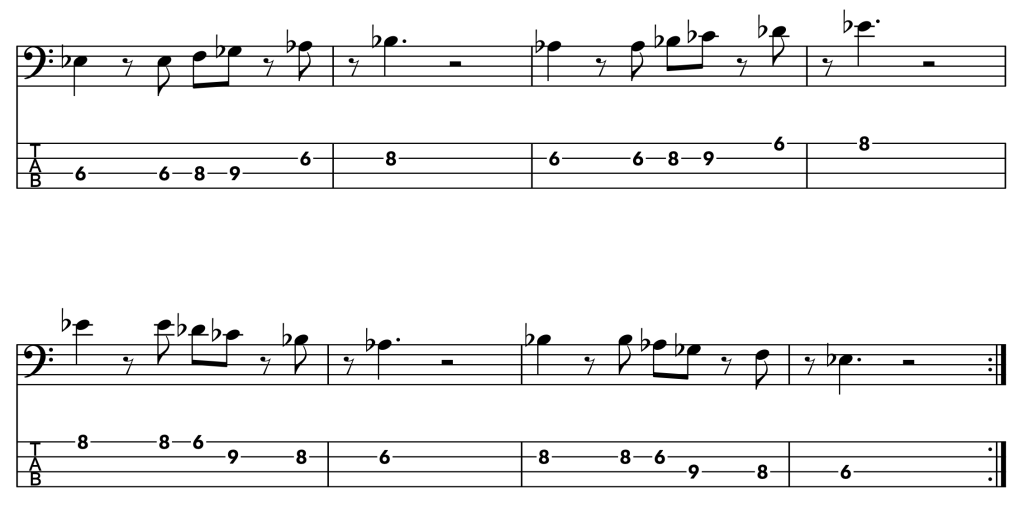
#6The Minor Pentatonic Scale

This is, quite possibly, the most used scale by bass players since the dawn of the electric bass. The minor pentatonic is the go to scale for anything and everything bluesy, funky, rock, metal, and groovy. It’s the swiss army knife of scales. It’s the salt in your kitchen. You can sprinkle it on just about everything and make it better.
It’s like the minor scale, but the real mean and evil notes are gone, and you’re left with a rugged, gritty, dirty, funky, bluesy framework that you can build the greatest of grooves upon.
Bass lines that use The Minor Pentatonic Scale
There are two comfy ways to play this scale, and I’ll show you both, starting with the static form.

Whipping Post
Berry Oakley’s bass line to the verses of Whipping Post by The Allman Brothers is a deep and groovy example of the static form of minor pentatonic:


The other form of the minor pentatonic is called the shifting form.
Moby Dick Riff
John Paul Jones rips through the minor pentatonic scale in this riff from Moby Dick. This is a challenging bass line. If you’re a beginner, take things real slowly, and only after you’ve got the scale fingering down.


How To Practice The Pentatonic Scale
Just like every other scale – get those patterns tattooed into your brain and fingers!
- First, the static form:


- And now, the shifting form (you can practice this form to the same playalongs above for the static form. They’ll sound the same, but will have different fingerings):


For a more melodic, practical and musical approach to practicing this scale, I’ll grab as many ideas from the riffs above as I can.
I’ll take the 4 note run that Oakley uses at the end of Whipping Post and turn that into scale practice. I’ll use his rhythm too, thus ensuring maximum grooviness.

When beginning players are asked to make their own bass lines with a scale, they often start playing lots and lots of different notes.
Stop doing that! Remember the mantra!
Never Underestimate the Power of Repeated Notes!
In Moby Dick, the riff has plenty of back and forth repetition. I’ll turn that into a scale practice exercise. Take two notes next to each other in the scale, and play them back and forth. That’s it.
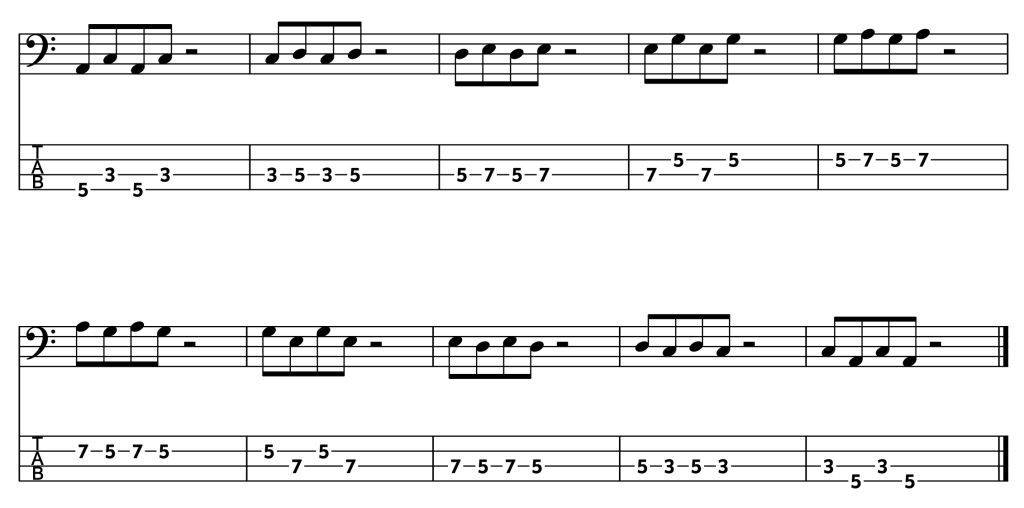
How To Make A Bass Line With The Minor Pentatonic Scale
If you talk to any good cook (hi Mom!), they usually say variations of the same thing: if you have good ingredients, you’ll make good food.
The scale practice you just did identified some wonderful, usable ingredients.
To make your own bass lines, experiment with combining these different ingredients in different ways.
Here are two examples in static form:


And just to make sure you have some ideas to play with in the shifting form, here’s a bass line inspired (ahem, stolen) from the Moby Dick bass part.

And Lo, it was then given unto the people the Minor Pentatonic Scale, and a voice shook the land saying ‘whosoever has this scale and also a good drummer shall be ever rich with funky grooves and tasty bass lines.’
– From A Real And Not Made Up History Of Bass Playing
#7The Blues Scale

It’s the Minor Pentatonic scale with one new note. One secret ingredient. Maybe some cayenne pepper? Cumin? A proprietary blend of spices?? It is a KILLER secret ingredient. It puts the devil in the music. It has all the blues and lip curl and sauce in it. If the minor pentatonic wasn’t gritty enough for you, if the minor scale was too classical sounding, this is the one to use.
There are two forms for the Blues Scale, static form and shifting form:


Bass lines that use The blues scale
Sunshine Of Your Love
Jack Bruce’s bass line in Sunshine Of Your Love uses every note of the blues scale. It is also one of the most iconic and classic rock lines of all time.
This riff will use the shifting form of the blues scale.


Bombtrack
Rage Against the Machine used the blues scale constantly in their killer bass line riff recipes. One of the most clear examples of the static form blues scale in action comes from the verse to Bombtrack.


Blues Scale
One last time – get that scale to be automatic in the fingers whether you’re on a high root note or a low root note.
I’ve set this up for practicing both the shifting and the static forms.
First, the shifting form:


Cool RHYTHM + notes of the SCALE = AWESOME bass line
Both of the song examples use cool rhythms and then just run through the scale form.
To practice the scale form more practically and musically, use the cool rhythms from these examples, and move them through the scale in different ways.
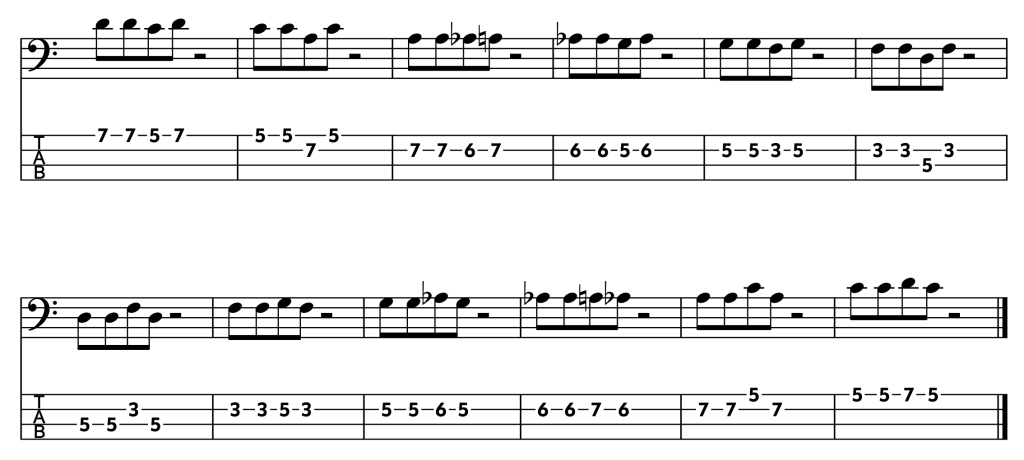
And now the static form for some Bombtrack practice (you can practice these to the same playalongs as above for the shifting form. They’ll sound the same even though they have different fingerings):




How To Make Your Own Bass Line Using The Blues Scale
Scale practice stocks and preps your bass line kitchen: you’re dicing the garlic, measuring out the spices – all of that.
Now – using the recipes above – start experimenting again.
In this experiment I’m going to unveil to you one of the great secrets of the bass-line-making world. THE RULE OF 4.
Here’s how it works.
- Start with a simple groove on your root note.
- Play it 1 time.
- The 2nd time you play it, add a small, extra thing to it.
- The 3rd time you play it, play it exactly like you did the first time.
- The 4th time you play it, do a little something fancy.
The extra thing and the little something fancy are going to come from the scale and from the ideas you’ve hammered into your ears and fingers from your practice.
Here’s an example using the musical practicing examples above, and putting it together (in static form) with the Rule of Four:

You now have 5 scale forms – the most common and essential ingredients in any bass player’s kitchen.
Now make sure you know how to use them.
Don’t be the internet bass player who learns scales, gets excited, invites their musician friends over for a dinner party and then serves them flour, raw meat, raw potatoes and a tomato and thinks it’s a hamburger.
Get in that kitchen and cook up your own delicious bass lines.


Comments
Got something to say? Post a comment below.